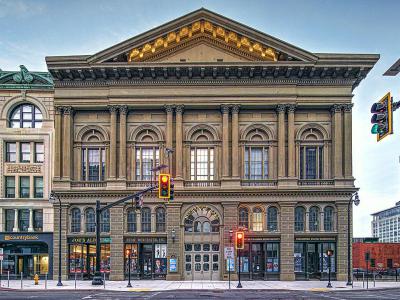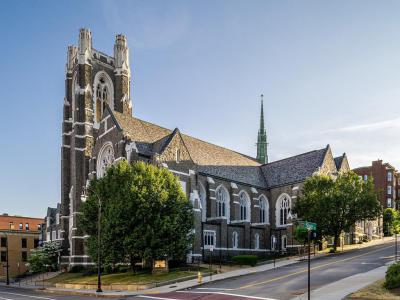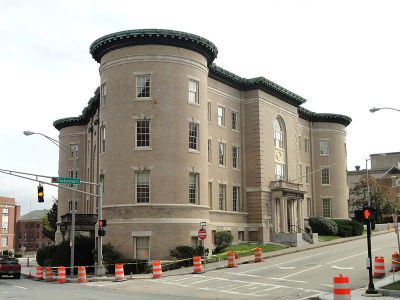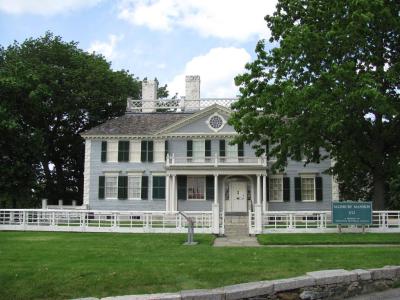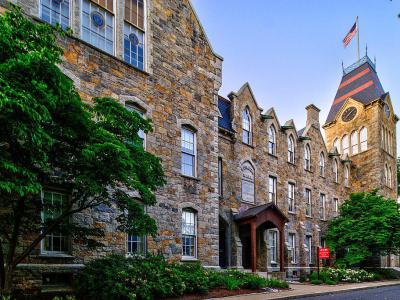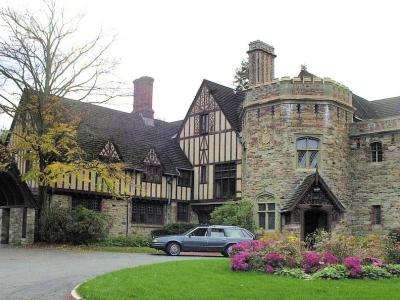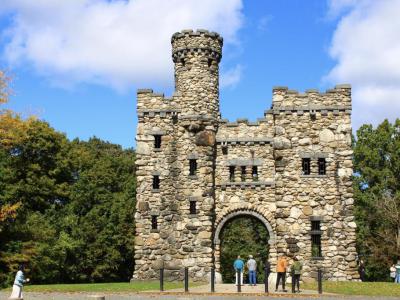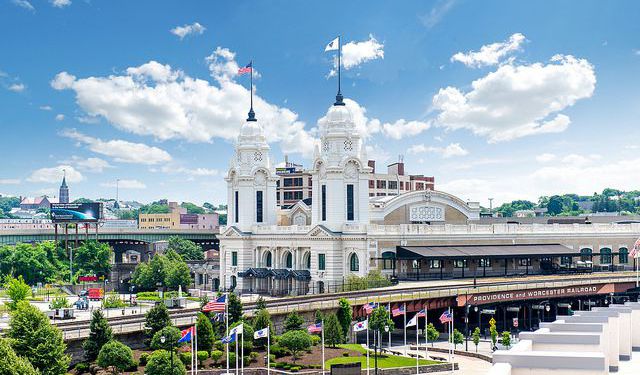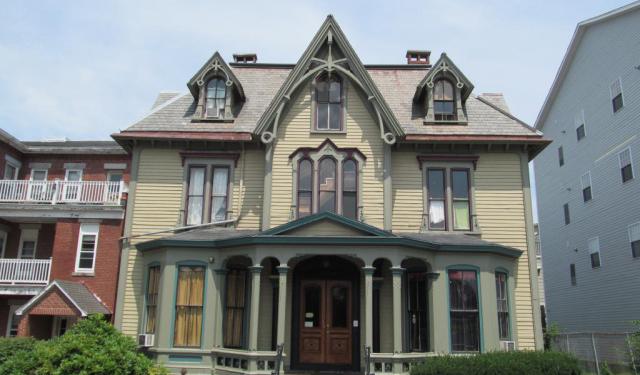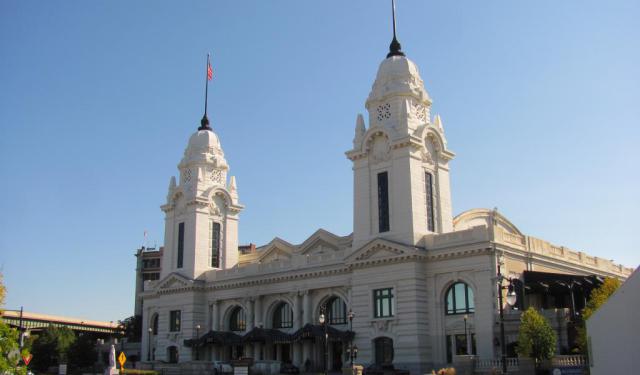
Worcester Architectural Jewels (Self Guided), Worcester
In Worcester, Massachusetts, you'll find a trove of architectural wonders reflecting the city's rich historical and cultural heritage. Among these jewels is Mechanics Hall, a stunning Victorian-era concert hall renowned for its complex design and exceptional acoustics. Nearby stands the Wesley United Methodist Church, an elegant example of Gothic Revival architecture, with its towering spire and intricate masonry.
Just a stone's throw away is the Worcester Memorial Auditorium, a grand Art Deco building that has hosted countless events and performances since the 1930s. Tuckerman Hall, another architectural gem, showcases beautiful Georgian Revival architecture and serves as a cultural hub for the community.
Venturing further, you'll encounter the Salisbury Mansion. This historic property, built in 1772, offers a glimpse into Worcester's past with its exquisite Greek Revival exterior. The meticulously preserved rooms and period furnishings provide a fascinating look at 18th-century life.
Boynton Hall at Worcester Polytechnic Institute impresses with its collegiate Gothic style, while the Aldus Chapin Higgins House exudes the charm of the Tudor design.
Perched atop Prospect Hill, Bancroft Tower stands as a picturesque folly, reminiscent of a medieval castle and offering panoramic views of the city, and is a great spot for a leisurely afternoon outing.
Each of these architectural marvels tells a story of Worcester's past, present, and future, inviting visitors to explore and appreciate their beauty and significance. As you wander through the streets of Worcester, take the time to admire these architectural jewels and delve into the history and culture they represent. Embark on this self-guided journey of discovery now and explore Worcester's architectural heritage for yourself!
Just a stone's throw away is the Worcester Memorial Auditorium, a grand Art Deco building that has hosted countless events and performances since the 1930s. Tuckerman Hall, another architectural gem, showcases beautiful Georgian Revival architecture and serves as a cultural hub for the community.
Venturing further, you'll encounter the Salisbury Mansion. This historic property, built in 1772, offers a glimpse into Worcester's past with its exquisite Greek Revival exterior. The meticulously preserved rooms and period furnishings provide a fascinating look at 18th-century life.
Boynton Hall at Worcester Polytechnic Institute impresses with its collegiate Gothic style, while the Aldus Chapin Higgins House exudes the charm of the Tudor design.
Perched atop Prospect Hill, Bancroft Tower stands as a picturesque folly, reminiscent of a medieval castle and offering panoramic views of the city, and is a great spot for a leisurely afternoon outing.
Each of these architectural marvels tells a story of Worcester's past, present, and future, inviting visitors to explore and appreciate their beauty and significance. As you wander through the streets of Worcester, take the time to admire these architectural jewels and delve into the history and culture they represent. Embark on this self-guided journey of discovery now and explore Worcester's architectural heritage for yourself!
How it works: Download the app "GPSmyCity: Walks in 1K+ Cities" from Apple App Store or Google Play Store to your mobile phone or tablet. The app turns your mobile device into a personal tour guide and its built-in GPS navigation functions guide you from one tour stop to next. The app works offline, so no data plan is needed when traveling abroad.
Worcester Architectural Jewels Map
Guide Name: Worcester Architectural Jewels
Guide Location: USA » Worcester (See other walking tours in Worcester)
Guide Type: Self-guided Walking Tour (Sightseeing)
# of Attractions: 8
Tour Duration: 2 Hour(s)
Travel Distance: 3.4 Km or 2.1 Miles
Author: Stella
Sight(s) Featured in This Guide:
Guide Location: USA » Worcester (See other walking tours in Worcester)
Guide Type: Self-guided Walking Tour (Sightseeing)
# of Attractions: 8
Tour Duration: 2 Hour(s)
Travel Distance: 3.4 Km or 2.1 Miles
Author: Stella
Sight(s) Featured in This Guide:
- Mechanics Hall
- Wesley United Methodist Church
- Worcester Memorial Auditorium
- Tuckerman Hall
- Salisbury Mansion
- Boynton Hall, Worcester Polytechnic Institute
- Aldus Chapin Higgins House
- Bancroft Tower
1) Mechanics Hall
Mechanics Hall in Worcester stands as a testament to both architectural grandeur and cultural significance. Built in 1857 in the Renaissance Revival style, the hall was originally constructed as part of the 19th-century worker’s improvement movement. It was later restored in 1977 and is now recognized as one of the top four concert halls in North America and among the twelve finest between Europe and the Americas. Today, it serves as a premier concert and performing arts venue, also housing a recording studio.
Founded in 1842, the Worcester Mechanics Association aimed to improve workers' skills in mill machinery. Mechanics Hall was built to support education and culture, featuring meeting rooms, a library, and two halls. Its third-floor concert hall, known for superb acoustics, attracted notable figures like Charles Dickens, Susan B. Anthony, Enrico Caruso, Ella Fitzgerald, Yo-Yo Ma, and Mel Tormé.
A significant historical moment occurred on April 3, 1910, when President William Howard Taft addressed labor issues at Mechanics Hall during a meeting of the Brotherhoods in Train Service. His visit was marked by a grand parade and the presence of several thousand New Englanders.
By the mid-20th century, Mechanics Hall declined alongside Worcester’s downtown, hosting sports events before falling into neglect. Threatened with demolition, it was saved by the Worcester Heritage Society, which raised $5 million for a 1977 restoration by Anderson Notter Finegold. This revival helped spark Worcester’s downtown resurgence.
Mechanics Hall continues to thrive as a hub for world-class performances, civic events, and educational initiatives, preserving its role as a cultural landmark in Worcester.
Founded in 1842, the Worcester Mechanics Association aimed to improve workers' skills in mill machinery. Mechanics Hall was built to support education and culture, featuring meeting rooms, a library, and two halls. Its third-floor concert hall, known for superb acoustics, attracted notable figures like Charles Dickens, Susan B. Anthony, Enrico Caruso, Ella Fitzgerald, Yo-Yo Ma, and Mel Tormé.
A significant historical moment occurred on April 3, 1910, when President William Howard Taft addressed labor issues at Mechanics Hall during a meeting of the Brotherhoods in Train Service. His visit was marked by a grand parade and the presence of several thousand New Englanders.
By the mid-20th century, Mechanics Hall declined alongside Worcester’s downtown, hosting sports events before falling into neglect. Threatened with demolition, it was saved by the Worcester Heritage Society, which raised $5 million for a 1977 restoration by Anderson Notter Finegold. This revival helped spark Worcester’s downtown resurgence.
Mechanics Hall continues to thrive as a hub for world-class performances, civic events, and educational initiatives, preserving its role as a cultural landmark in Worcester.
2) Wesley United Methodist Church
Wesley United Methodist Church emerged from the union of the Grace and Trinity congregations, reflecting a rich history of community and faith. The construction of this significant church began in 1924 and was completed in 1927, marking the beginning of its service to the faithful. The building stands as a remarkable example of late Gothic Revival architecture, characterized by its intricate designs and majestic presence.
The church's architectural grandeur is evident in its detailed stonework, towering spires, and expansive stained glass windows, all hallmarks of the Gothic Revival style. The interior is equally impressive, with a sanctuary designed to inspire awe and reverence. The high vaulted ceilings, elegant woodwork, and meticulously crafted stone details create an atmosphere of serene beauty and spiritual reflection.
Beyond its role as a place of worship, Wesley United Methodist Church is renowned for its exceptional acoustics, making it a favored venue for musical performances in downtown Worcester. The sanctuary's design enhances the quality of sound, attracting musicians and audiences alike for concerts, recitals, and other cultural events. This dual function as a religious and cultural hub highlights the church's integral role in the community.
The church's architectural grandeur is evident in its detailed stonework, towering spires, and expansive stained glass windows, all hallmarks of the Gothic Revival style. The interior is equally impressive, with a sanctuary designed to inspire awe and reverence. The high vaulted ceilings, elegant woodwork, and meticulously crafted stone details create an atmosphere of serene beauty and spiritual reflection.
Beyond its role as a place of worship, Wesley United Methodist Church is renowned for its exceptional acoustics, making it a favored venue for musical performances in downtown Worcester. The sanctuary's design enhances the quality of sound, attracting musicians and audiences alike for concerts, recitals, and other cultural events. This dual function as a religious and cultural hub highlights the church's integral role in the community.
3) Worcester Memorial Auditorium
The Worcester Memorial Auditorium is a historic multi-purpose arena. Completed in 1933, the Auditorium was built as a World War I memorial and serves as a testament to the city's dedication to honoring its war heroes. With a 116-foot-wide proscenium, the structure was designed to host a variety of events, showcasing its versatility as a multi-purpose hall.
The architectural grandeur of the Worcester Auditorium is matched by its historical significance. The building stands as one of the key landmarks in Lincoln Square, an area recently recognized by Preservation Massachusetts as one of the "Most Endangered Historic Resources" in the state. This designation highlights the precarious state of the square, where three notable historical buildings, including the Auditorium, remain either empty or underutilized. The Auditorium, with its impressive facade and vast interior, is a prominent feature of this endangered historical enclave.
Currently, the Worcester Memorial Auditorium is not utilized to its full potential. It primarily serves as a storage facility for Massachusetts State Trial Court records and hosts a small after-school program. This limited use underscores the ongoing challenges faced in preserving and repurposing historic structures, especially ones as significant as the Auditorium. Efforts to rejuvenate and repurpose the building could play a vital role in the broader revitalization of Lincoln Square.
The architectural grandeur of the Worcester Auditorium is matched by its historical significance. The building stands as one of the key landmarks in Lincoln Square, an area recently recognized by Preservation Massachusetts as one of the "Most Endangered Historic Resources" in the state. This designation highlights the precarious state of the square, where three notable historical buildings, including the Auditorium, remain either empty or underutilized. The Auditorium, with its impressive facade and vast interior, is a prominent feature of this endangered historical enclave.
Currently, the Worcester Memorial Auditorium is not utilized to its full potential. It primarily serves as a storage facility for Massachusetts State Trial Court records and hosts a small after-school program. This limited use underscores the ongoing challenges faced in preserving and repurposing historic structures, especially ones as significant as the Auditorium. Efforts to rejuvenate and repurpose the building could play a vital role in the broader revitalization of Lincoln Square.
4) Tuckerman Hall
Tuckerman Hall, constructed in 1902, serves as a testament to the vision and generosity of Stephen Salisbury III. Intended as the residence of the Worcester Woman’s Club, the hall was built on a lot donated by Salisbury and named in honor of his grandmother, Elizabeth Tuckerman. The building's design was the work of Josephine Wright Chapman, a renowned architect of the time, who skillfully blended various stylistic elements to create a masterpiece.
Chapman's design for Tuckerman Hall incorporates influences from Georgian, Federal, and Greek Revival architecture, resulting in a building that is both symmetrical and elegant. These design choices contribute to its recognition as one of New England's architectural treasures. The hall's exterior and interior reflect a harmonious mix of classical styles, with meticulous attention to detail that underscores its historic and aesthetic significance.
Tuckerman Hall functions as a versatile venue, hosting a wide range of community events. It is a preferred location for concerts, lectures, weddings, and musical performances, thanks to its acoustical qualities and elegant setting. The hall’s adaptability makes it a central hub for cultural and social gatherings in Worcester, enhancing its role as a vital part of the community’s fabric.
Chapman's design for Tuckerman Hall incorporates influences from Georgian, Federal, and Greek Revival architecture, resulting in a building that is both symmetrical and elegant. These design choices contribute to its recognition as one of New England's architectural treasures. The hall's exterior and interior reflect a harmonious mix of classical styles, with meticulous attention to detail that underscores its historic and aesthetic significance.
Tuckerman Hall functions as a versatile venue, hosting a wide range of community events. It is a preferred location for concerts, lectures, weddings, and musical performances, thanks to its acoustical qualities and elegant setting. The hall’s adaptability makes it a central hub for cultural and social gatherings in Worcester, enhancing its role as a vital part of the community’s fabric.
5) Salisbury Mansion
Salisbury Mansion is the city's only historic house museum. This notable structure was built in 1772 as a dual-purpose house and store by Stephen Salisbury, a prominent "gentleman-merchant." Initially serving as both a residence and a place of business, the mansion's store operations ceased following the Embargo of 1812, and by 1820, the entire space previously used for commercial purposes had been converted into additional living quarters.
Over the centuries, Salisbury Mansion has undergone numerous transformations, reflecting its adaptability and the changing needs of its occupants. It has functioned as a rooming house and even a gentleman's club. Originally situated at Lincoln Square, the mansion was eventually relocated to its current site. Through meticulous research and extensive documentation, the mansion has been restored to its 1830s appearance, a period when it was the home of Elizabeth Tuckerman Salisbury, the widow of Stephen Salisbury.
The careful attention to detail in restoring the mansion provides visitors with an authentic glimpse into the life and times of its past inhabitants. The museum's comprehensive documentation includes original furnishings, period-appropriate decor, and detailed accounts of the Salisbury family's lifestyle, making it one of the best-documented historic house museums in New England.
Over the centuries, Salisbury Mansion has undergone numerous transformations, reflecting its adaptability and the changing needs of its occupants. It has functioned as a rooming house and even a gentleman's club. Originally situated at Lincoln Square, the mansion was eventually relocated to its current site. Through meticulous research and extensive documentation, the mansion has been restored to its 1830s appearance, a period when it was the home of Elizabeth Tuckerman Salisbury, the widow of Stephen Salisbury.
The careful attention to detail in restoring the mansion provides visitors with an authentic glimpse into the life and times of its past inhabitants. The museum's comprehensive documentation includes original furnishings, period-appropriate decor, and detailed accounts of the Salisbury family's lifestyle, making it one of the best-documented historic house museums in New England.
6) Boynton Hall, Worcester Polytechnic Institute
Boynton Hall, the principal building of Worcester Polytechnic Institute (WPI), stands as a symbol of the university's long-standing tradition of academic excellence and innovation. Established in 1865, the hall was a generous contribution from John Boynton, a prominent tinware manufacturer, who envisioned creating an institution dedicated to the practical and theoretical sciences. Today, WPI is recognized as a tier-one university, consistently ranked in the top 25% by U.S. News & World Report, and Boynton Hall remains at the heart of its historic campus.
Designed by Stephen Carpenter Earle, a distinguished architect renowned for his creative contributions to Worcester's architectural landscape, Boynton Hall is a testament to the Gothic Revival style. The building's construction from pure granite imparts a sense of durability and timelessness, reflecting the institution's commitment to enduring educational values. Its design features characteristic elements of the Gothic Revival style, such as pointed arches, intricate stonework, and a vertical emphasis that evokes the grandeur of medieval cathedrals.
The legacy of Boynton Hall is further enriched by the contributions of Stephen Earle's son, Rear Admiral Ralph Earle, who later became the president of WPI. Under his leadership, the institute continued to thrive and expand its influence in the fields of science and engineering. His tenure as president is a testament to the enduring impact of the Earle family's dedication to the institution and its mission.
Designed by Stephen Carpenter Earle, a distinguished architect renowned for his creative contributions to Worcester's architectural landscape, Boynton Hall is a testament to the Gothic Revival style. The building's construction from pure granite imparts a sense of durability and timelessness, reflecting the institution's commitment to enduring educational values. Its design features characteristic elements of the Gothic Revival style, such as pointed arches, intricate stonework, and a vertical emphasis that evokes the grandeur of medieval cathedrals.
The legacy of Boynton Hall is further enriched by the contributions of Stephen Earle's son, Rear Admiral Ralph Earle, who later became the president of WPI. Under his leadership, the institute continued to thrive and expand its influence in the fields of science and engineering. His tenure as president is a testament to the enduring impact of the Earle family's dedication to the institution and its mission.
7) Aldus Chapin Higgins House
Aldus Chapin Higgins House, one of Worcester's most remarkable historic treasures, stands as a testament to early 20th-century architecture and the legacy of its namesake, Aldus Chapin Higgins. Completed in 1923, this stunning residence was designed by the acclaimed architect Grosvenor Atterbury in the Tudor Revival style. Higgins, an esteemed graduate of Worcester Polytechnic Institute (WPI), commissioned the house, which features design elements reminiscent of the Compton Wynyates Castle in Warwickshire, England. This influence is evident in the house's charming, medieval-inspired aesthetics, complete with a quintessential English garden.
Higgins House was more than just a family residence; it was a symbol of the Higgins family's deep ties to WPI and the Worcester community. Aldus's wife, May, who played a pivotal role in maintaining the house's legacy, bequeathed the property to WPI upon her death. Today, it serves as the headquarters for the Office of Alumni Relations, hosting various alumni events and fostering a continued connection between the university and its graduates. The house's transformation into an alumni hub underscores its ongoing importance to WPI, blending historic charm with a vibrant role in the institution's community.
Architecturally, Higgins House is a masterpiece of Tudor Revival style, characterized by its steeply pitched gable roofs, decorative half-timbering, and ornate masonry. The attention to detail in its design and construction has earned it a place on the National Register of Historic Places, a designation it received in 1980. The house's interiors and exteriors alike are adorned with period-appropriate features that transport visitors to a bygone era, while the meticulously maintained gardens offer a serene and picturesque setting reminiscent of English country estates.
In addition to its architectural and historical significance, Higgins House continues to be a focal point for WPI's alumni activities, bridging the past and present. Its role as a venue for alumni events ensures that the legacy of Aldus Chapin Higgins and his contributions to WPI are remembered and celebrated.
Higgins House was more than just a family residence; it was a symbol of the Higgins family's deep ties to WPI and the Worcester community. Aldus's wife, May, who played a pivotal role in maintaining the house's legacy, bequeathed the property to WPI upon her death. Today, it serves as the headquarters for the Office of Alumni Relations, hosting various alumni events and fostering a continued connection between the university and its graduates. The house's transformation into an alumni hub underscores its ongoing importance to WPI, blending historic charm with a vibrant role in the institution's community.
Architecturally, Higgins House is a masterpiece of Tudor Revival style, characterized by its steeply pitched gable roofs, decorative half-timbering, and ornate masonry. The attention to detail in its design and construction has earned it a place on the National Register of Historic Places, a designation it received in 1980. The house's interiors and exteriors alike are adorned with period-appropriate features that transport visitors to a bygone era, while the meticulously maintained gardens offer a serene and picturesque setting reminiscent of English country estates.
In addition to its architectural and historical significance, Higgins House continues to be a focal point for WPI's alumni activities, bridging the past and present. Its role as a venue for alumni events ensures that the legacy of Aldus Chapin Higgins and his contributions to WPI are remembered and celebrated.
8) Bancroft Tower (must see)
Сonstructed around 1900, Bancroft Tower is a monument built to honor George Bancroft, a distinguished figure born on nearby Salisbury Street. Bancroft was a prominent historian and statesman, serving as the U.S. Secretary of the Navy, founding the U.S. Naval Academy, and acting as the U.S. Minister to Great Britain and Germany. His significant contributions to the nation and his close ties to the Salisbury family inspired Stephen Salisbury III to fund the tower's construction as a tribute to his esteemed friend.
Designed by the architects Stephen C. Earle and C. Fisher, Bancroft Tower showcases elements of Romanesque architectural style. This striking structure, built at a cost of approximately $15,000, is characterized by its robust and rustic aesthetic, featuring thick stone walls, rounded arches, and a rugged, medieval appearance. The tower’s design reflects the romanticism and historical revivalism popular in architecture at the turn of the century, making it a notable example of this stylistic approach in Worcester.
Beyond its historical significance, Bancroft Tower serves as a popular spot for outdoor recreation. The surrounding area provides a picturesque setting for visitors, offering scenic views and a tranquil environment for picnics, walks, and leisurely exploration. The tower's elevated position offers panoramic vistas of the city and its surroundings, making it a beloved landmark for both locals and tourists.
In recognition of its historical and architectural importance, Bancroft Tower was listed on the National Register of Historic Places.
Designed by the architects Stephen C. Earle and C. Fisher, Bancroft Tower showcases elements of Romanesque architectural style. This striking structure, built at a cost of approximately $15,000, is characterized by its robust and rustic aesthetic, featuring thick stone walls, rounded arches, and a rugged, medieval appearance. The tower’s design reflects the romanticism and historical revivalism popular in architecture at the turn of the century, making it a notable example of this stylistic approach in Worcester.
Beyond its historical significance, Bancroft Tower serves as a popular spot for outdoor recreation. The surrounding area provides a picturesque setting for visitors, offering scenic views and a tranquil environment for picnics, walks, and leisurely exploration. The tower's elevated position offers panoramic vistas of the city and its surroundings, making it a beloved landmark for both locals and tourists.
In recognition of its historical and architectural importance, Bancroft Tower was listed on the National Register of Historic Places.
Walking Tours in Worcester, Massachusetts
Create Your Own Walk in Worcester
Creating your own self-guided walk in Worcester is easy and fun. Choose the city attractions that you want to see and a walk route map will be created just for you. You can even set your hotel as the start point of the walk.
Worcester Introduction Walking Tour
Known as the "Heart of the Commonwealth," Worcester's central location in Massachusetts has played a pivotal role in its development from a quiet settlement to a bustling urban center.
The name "Worcester" is taken from the city in England. The Massachusetts counterpart was incorporated in 1722 and has since grown into the second-largest city in New England. Its growth... view more
Tour Duration: 2 Hour(s)
Travel Distance: 2.3 Km or 1.4 Miles
The name "Worcester" is taken from the city in England. The Massachusetts counterpart was incorporated in 1722 and has since grown into the second-largest city in New England. Its growth... view more
Tour Duration: 2 Hour(s)
Travel Distance: 2.3 Km or 1.4 Miles
Worcester Historic Houses Walk
Worcester, Massachusetts, is not just a hub of modern development and educational excellence; it also harbors a rich collection of historic residences, each with its own story and architectural significance. These houses offer a glimpse into the lives of some of the city's influential figures from various periods and the architectural trends that shaped their homes.
One of the notable... view more
Tour Duration: 1 Hour(s)
Travel Distance: 1.9 Km or 1.2 Miles
One of the notable... view more
Tour Duration: 1 Hour(s)
Travel Distance: 1.9 Km or 1.2 Miles
Canal District Walking Tour
The Canal District in Worcester, Massachusetts, is a lively and historic area that has seen considerable rejuvenation recently. Originally home to the Blackstone Canal, instrumental in Worcester's industrial boom during the 19th century, the neighborhood has evolved into a vibrant center of activity. It skillfully merges Worcester’s industrial past with contemporary urban growth, showcasing... view more
Tour Duration: 2 Hour(s)
Travel Distance: 2.1 Km or 1.3 Miles
Tour Duration: 2 Hour(s)
Travel Distance: 2.1 Km or 1.3 Miles
The Most Popular Cities
/ view all
